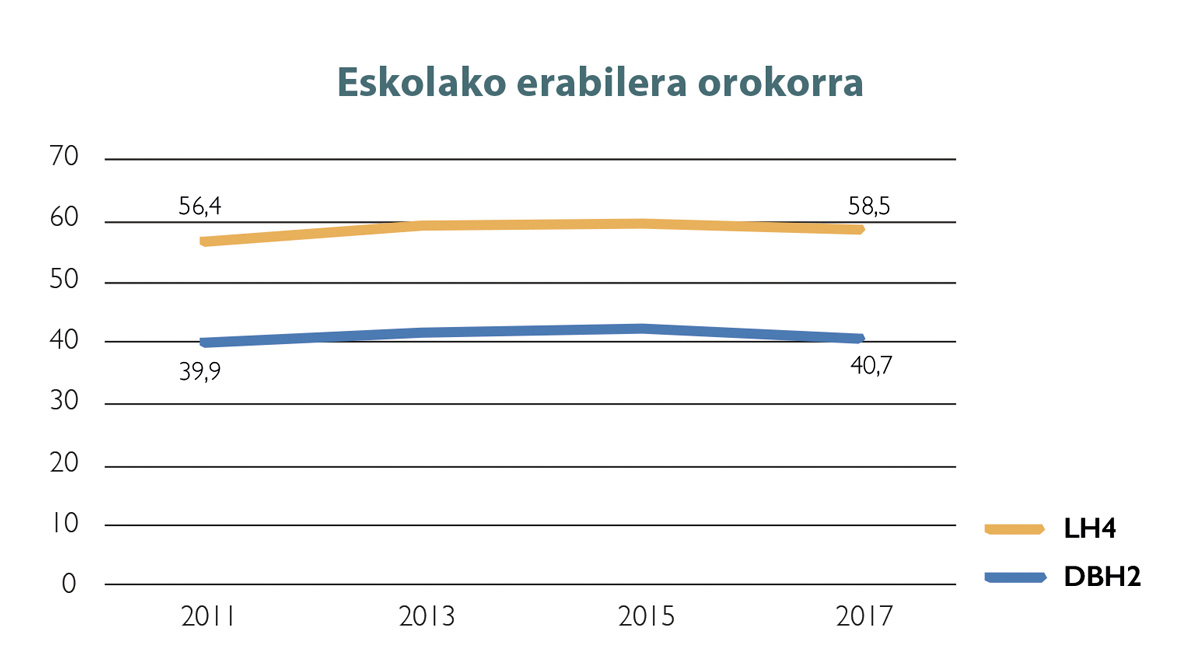
- According to the Arrue study, the upward trend in use has stagnated. Between 2011 and 2015, at CAPV, FP4 and DBH2 students increased their use in school. By contrast, data for 2017 show a downward trend. In model D, the backward steps are more evident. The 2019 data will be published in the autumn, when it will be possible to verify whether the recession will continue or whether the 2017 data are exceptional.

The Arrue study was launched in 2004. It has a main focus of attention: To analyze the linguistic uses of CAPV students in the school environment. Since 2011 and with a period of two years, the linguistic uses of the school have been analyzed through student surveys. Thus, today the results of 2011, 2013, 2015 and 2017 can be compared. The 2019 results are being prepared. The data of the study were elaborated by the Cluster of Sociolinguistics commissioned by the Basque Government.
They measure four types of uses in the school environment: with classmates in the classroom, with peers in the backyard, with teachers in the classroom, and with teachers outside the classroom. They regularly host two-tier pupils: 4th Primary Education (9-10 years) and 2nd Compulsory Secondary Education (13-14 years).
Looking at the evolution from 2011 to 2017, it is noted that the overall use of the school (the average of the four types of uses we have just mentioned) maintains a similar level. In both LH4 and DBH2, there is a slight upward trend, an increase of 2.1 points and an increase of 0.8 points respectively.
Rather than looking at the overall evolution, if you look at the difference between 2015 and 2017, you see that the upward trend has been downward. In LH4 three of the four types of use fall and in DBH 2 all fall. The 2019 results that will arrive in the autumn will be significant to confirm or reverse the downward trend shown by the 2017 data.
Model D is reducing its use since 2011
Taking into account the four types of use and the two school courses, data for 2017 are lower than for 2011. There is only one exception: When the LH4 teammates work together in the yard. Between 2011 and 2017, the overall use of LH4 drops by 2.2 points and that of DBH 2 by 4.1. It has decreased mainly from 2015 to 2017.
.jpg)

Reflections of the authors
The research, in addition to providing data of use, has collected some sociolinguistic reflections of the authors Iñaki Martínez de Luna and Pablo Suberbiola. The report points out, among other things, that the school environment is significantly more Basque than the average of society, and that the difference is very evident in certain ages and types of uses. For example, when boys and girls between the ages of 9 and 10 are in the classroom with their peers and peers, the use of the Basque Country is 66.5% and the average household use at these ages is 29.5%. However, the authors have put on the table the limits of the school for the maintenance of use and have given a very different example: When kids from 13 to 14 years old are playing with their peers use is 21.8% and domestic use is almost 21%. The report has taken account of the prospect of socialisation in interpreting this type of data. In other words, the larger the students, the larger the socialization areas, the school is nothing more than one of the different socialization areas. Likewise, in the CAPV, almost all social environments are more Castilan-speaking than the school environment, so students are increasingly influenced by these Castilian and Spanish social environments. It is not by chance that the lowest levels of use of the Basque Country of the four types of use measured by the research occur in the section of ‘patio with colleagues’, in a situation closer to the reality of the street.
The report makes a number of comments on model D. One of the reflections points out that the Euskaldunization of the new generations has often been put in the hands of the school too much, and that perhaps it is thought that “as they are working on model D”, students will have the conditions to be able to express themselves in Euskera. The authors of the report say this: “There are reasons to think that in different areas and educational centers, for teachers and those responsible, it is increasingly difficult to offer students an effective Basque environment within model D”. Your proposal is to reflect on the complements, reinforcements or new resources needed to balance these difficulties.
Another reflection on model D focuses on the teaching staff. Between 2011 and 2017 there has been a decrease in the use of LH4 boys and girls in their relationships with teachers outside the classroom. The report proposes to analyse the changes that have taken place in linguistic uses between teachers and teachers over the past seven years and their causes. And that's what determines it. “There will surely be a need for new resources or reinforcements to maintain or go beyond the existing levels of teacher use in Basque.”